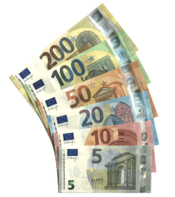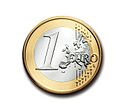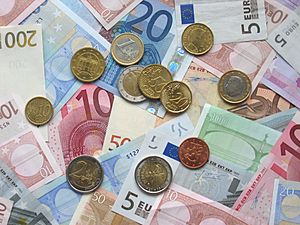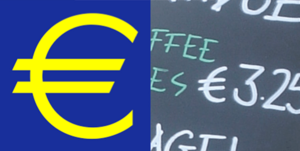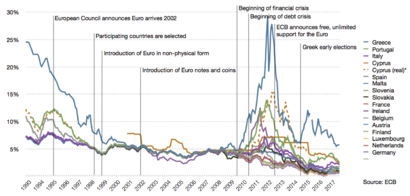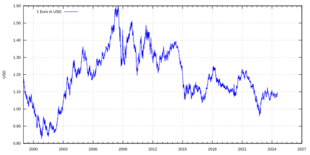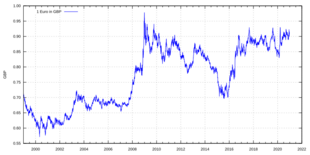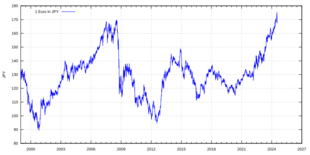Euro facts for kids
Quick facts for kids Euro |
|||||
|---|---|---|---|---|---|
|
|||||
| ISO 4217 Code | EUR | ||||
| User(s) | primary: § members of Eurozone (20), also: § other users |
||||
| Inflation | 2.6% (July 2024) | ||||
| Source | ec.europa.eu | ||||
| Method | HICP | ||||
| Pegged by | see § Pegged currencies | ||||
| Subunit | |||||
| 1⁄100 | euro cent (Name varies by language) |
||||
| Symbol | € | ||||
| euro cent | c | ||||
| Nickname | The single currency | ||||
| Plural | Varies, see language and the euro | ||||
| euro cent | (Varies by language) | ||||
| Coins | |||||
| Freq. used | 1c, 2c, 5c, 10c, 20c, 50c, €1, €2 | ||||
| Rarely used | 1c, 2c (Belgium, Finland, Ireland, Italy, Netherlands, Slovakia) | ||||
| Banknotes | |||||
| Freq. used | €5, €10, €20, €50, €100, €200 | ||||
| Rarely used | €500 | ||||
| Printer | see § Banknote printing | ||||
The euro (symbol: €; currency code: EUR) is the official money used by 20 of the countries in the European Union. This group of countries is called the eurozone. The euro is divided into 100 euro cents.
The euro is also used by the official groups of the European Union. Four small European countries that are not EU members also use it. These are Andorra, Monaco, San Marino, and Vatican City. The British territory of Akrotiri and Dhekelia also uses the euro. Additionally, Montenegro and Kosovo use the euro on their own. Many other places outside Europe also use the euro. More than 200 million people around the world use money that is linked to the euro.
The euro is the second most important money in the world. It is used for international savings and is traded a lot, right after the United States dollar. As of 2019, there was over €1.3 trillion in euro banknotes and coins. This makes it one of the currencies with the highest total value in circulation.
The name euro was officially chosen on December 16, 1995, in Madrid, Spain. The euro started being used for financial records on January 1, 1999. It replaced the old European Currency Unit (ECU). One euro was worth the same as one ECU. The actual euro coins and banknotes started to be used on January 1, 2002. By March 2002, the euro had completely replaced the old money in its first member countries.
Contents
How the Euro Works
Who Manages the Euro?

The European Central Bank (ECB) in Frankfurt am Main, Germany, manages the euro. The Eurosystem also helps. This system includes the central banks of all the eurozone countries. The ECB is an independent bank. It decides how much money should be in circulation.
The Eurosystem helps print and make euro banknotes and coins. It also helps distribute them in all member countries. They also manage how payments are made across the eurozone.
In 1992, the Maastricht Treaty was signed. This agreement said that most EU countries must adopt the euro. They have to meet certain money and budget rules first. Not all countries have done this yet. Denmark chose not to adopt the euro. Sweden also decided not to join the euro in a vote in 2003. All countries that joined the EU after 1993 have promised to adopt the euro later.
Countries Using the Euro
Eurozone Members
There are 20 countries that officially use the euro. They are:
Special Territories Using the Euro
Some special areas connected to EU countries also use the euro. These include:
EU Outermost Regions:
Overseas Territories:
Special Autonomous Territories:
 Greece
Greece
 Mount Athos
Mount Athos
Other Countries Using the Euro
Some other places use the euro even if they are not part of the eurozone.
Small Countries with Agreements:
British Territory:
Countries Using it on Their Own:
EU Countries Not Using the Euro
Some EU countries are expected to adopt the euro later. They do not have a set date to do so. They can delay by not meeting the economic rules. Bulgaria and Romania are working to adopt the euro. Other countries do not have a plan yet.
 Bulgaria: Bulgaria hopes to use the euro by 2026.
Bulgaria: Bulgaria hopes to use the euro by 2026. Czech Republic
Czech Republic Hungary
Hungary Poland
Poland Romania: Romania plans to adopt the euro by 2029.
Romania: Romania plans to adopt the euro by 2029. Sweden
Sweden
Countries That Chose Not to Use the Euro
Denmark decided to keep its own money. It has a special agreement to opt out of using the euro.
Euro Coins and Banknotes
Euro Coins
The euro is divided into 100 cents. These are sometimes called euro cents. All euro coins have a common side that shows their value and a map. The map on newer coins shows all of Europe. The 1, 2, and 5-cent coins still show the map of the 15 EU countries from 2002. Luc Luycx designed all the common sides.
Coins also have a national side. This side shows a picture chosen by the country that made the coin. You can use euro coins from any member country in any other country that uses the euro.
Coins come in values of €2, €1, 50c, 20c, 10c, 5c, 2c, and 1c. In some countries like Finland and Italy, cash payments are rounded to the nearest five cents. This is to avoid using the smallest 1 and 2-cent coins.
Commemorative Coins
Special €2 commemorative coins are made with different national designs. These coins are legal to use everywhere in the eurozone. For example, Greece made a coin for the 2004 Summer Olympics. There are also collector coins with other values. These are not for everyday use and are only legal in the country that issued them.
Where Euro Coins Are Made
Many places are allowed to make euro coins:
- Bayerisches Hauptmünzamt (Germany)
- Currency Centre (Ireland)
- Fábrica Nacional de Moneda y Timbre-Real Casa de la Moneda (Spain)
- Hamburgische Münze (Germany)
- Hrvatska kovnica novca (Croatia)
- Ίδρυμα Εκτύπωσης Τραπεζογραμματίων και Αξιών (Greece)
- Imprensa Nacional-Casa da Moeda (Portugal)
- Istituto Poligrafico e Zecca dello Stato (Italy)
- Koninklijke Munt van België/Monnaie Royale de Belgique (Belgium)
- Koninklijke Nederlandse Munt (Netherlands)
- Lietuvos monetų kalykla (Lithuania)
- Mincovňa Kremnica (Slovakia)
- Monnaie de Paris (France)
- Münze Österreich (Austria)
- Suomen Rahapaja/Myntverket i Finland (Finland)
- Staatliche Münze Berlin (Germany)
- Staatliche Münzen Baden-Württemberg (Germany)
Euro Banknotes
Euro banknotes have the same design on both sides. An Austrian designer named Robert Kalina created them. Notes come in values of €500, €200, €100, €50, €20, €10, and €5. Each banknote has a different color. They show different styles of European architecture. The front of the notes shows windows or gateways. The back shows bridges. These designs symbolize connections between countries and with the future.
A newer series of banknotes, called the Europa series, was introduced. This series does not include the €500 note anymore. Its production stopped in April 2019. However, both the old and new series of euro banknotes, including the €500, are still legal to use.
In December 2021, the ECB announced plans to redesign euro banknotes by 2024. People from each euro area country will suggest new themes. The public will vote on these ideas. There will also be a design competition.
Who Prints Euro Banknotes
Countries can print their own euro banknotes or have them printed. As of November 2022, these are some of the printers:
- Istituto Poligrafico e Zecca dello Stato (Italy)
- Banco de Portugal (Portugal)
- Bank of Greece (Greece)
- Banque de France (France)
- Bundesdruckerei (Germany)
- Central Bank of Ireland (Ireland)
- De La Rue (UK)
- Fábrica Nacional de Moneda y Timbre (Spain)
- François-Charles Oberthur (France)
- Giesecke & Devrient (Germany)
- Royal Joh. Enschedé (Netherlands)
- National Bank of Belgium (Belgium)
- Oesterreichische Nationalbank (Austria)
- Setec Oy (Finland)
Easy Payments with the Euro
It is easy to transfer money within the EU. All transfers in euro between EU countries are treated like local payments. This means they have the same low costs. This applies even to EU countries that do not use the euro, as long as the payment is in euro. Using credit/debit cards and ATMs within the eurozone also costs the same as local transactions. The ECB also has a system called TARGET. This system helps with large euro payments.
History of the Euro
How the Euro Started
The euro was created by the Maastricht Treaty in 1992. To join the euro, countries had to meet strict rules. For example, their budget deficit had to be less than 3% of their total economy. Their debt had to be less than 60% of their economy. They also needed low inflation and interest rates. The United Kingdom and Denmark were allowed to opt out of using the euro.
The name "euro" was officially chosen in Madrid on December 16, 1995. A Belgian teacher named Germain Pirlot is said to have suggested the name "euro" in a letter in August 1995.
The euro started as an electronic currency on January 1, 1999. The old national currencies of the participating countries stopped existing on their own. Their exchange rates were fixed against each other. The euro took over from the European Currency Unit (ECU). The actual notes and coins of the old currencies were still used until new euro notes and coins came out on January 1, 2002.
The period for exchanging old money for euros lasted about two months. It ended on February 28, 2002. The exact date when old money stopped being legal varied by country. In Germany, the Deutsche Mark stopped being legal on December 31, 2001. Even after old currencies were no longer legal, national central banks often accepted them for exchange for many years, or even forever in some countries.
The Euro Symbol
A special euro currency sign (€) was designed. The European Commission chose the winning design.
The European Commission explained the symbol:
The symbol € is based on the Greek letter epsilon (Є). It is the first letter in the word "Europe". The two parallel lines mean stability.
The European Commission also set exact rules for the euro logo. How the symbol is placed next to the amount (like €5 or 5 €) changes from country to country. However, for English texts from EU groups, the symbol (€) or "EUR" should come before the amount.
Eurozone Challenges
After the financial crisis in 2008, some European countries faced big debt problems. This became very serious in early 2010. Greece was hit the hardest. Other countries like Cyprus, Ireland, Italy, Portugal, and Spain were also affected. These countries received help from EU funds, except for Italy.
Some people believe the crisis was also political. They say the eurozone lacked the strong support and unity of a single country. The rules for joining the euro were not always followed strictly. For example, Germany and France broke the rules about budget deficits for several years.
Euro's Global Use

Note: The Belarusian rouble is pegged to the euro, Russian rouble and US dollar in a currency basket.
Countries with Currencies Linked to the Euro
Outside the eurozone, some EU countries have their money linked to the euro. This is a step towards joining the eurozone. The Danish krone and Bulgarian lev are linked because they are part of the ERM II.
Also, 21 other countries and territories outside the EU have their money directly linked to the euro. Many of these countries used to link their money to other major European currencies. When those currencies were replaced by the euro, their money became linked to the euro. Linking a country's money to a strong currency like the euro helps keep it stable. This prevents high inflation and encourages foreign investment.
As of 2013, 182 million people in Africa use money linked to the euro. Another 27 million people in Europe outside the eurozone use money linked to it. About 545,000 people on Pacific islands also use money linked to the euro.
The money of these countries is linked to the euro:
North America
 Haiti (Haitian gourde, HTG)
Haiti (Haitian gourde, HTG)
Europe
 Albania (Albanian lek, ALL)
Albania (Albanian lek, ALL) Bosnia and Herzegovina (Bosnia and Herzegovina convertible mark, BAM)
Bosnia and Herzegovina (Bosnia and Herzegovina convertible mark, BAM) Bulgaria (Bulgarian lev, BGN)
Bulgaria (Bulgarian lev, BGN) Denmark (Danish krone, DKK)
Denmark (Danish krone, DKK) North Macedonia (Macedonian denar, MKD)
North Macedonia (Macedonian denar, MKD) Sovereign Military Order of Malta (Maltese scudo)
Sovereign Military Order of Malta (Maltese scudo) Moldova (Moldovan leu, MDL)
Moldova (Moldovan leu, MDL) Romania (Romanian leu, RON)
Romania (Romanian leu, RON) Serbia (Serbian dinar, RSD)
Serbia (Serbian dinar, RSD)
Oceania
 French Polynesia (CFP franc, XPF)
French Polynesia (CFP franc, XPF) New Caledonia (CFP franc)
New Caledonia (CFP franc) Wallis and Futuna (CFP franc)
Wallis and Futuna (CFP franc)
Africa
 Burundi (Burundi franc, BIF)
Burundi (Burundi franc, BIF) Cape Verde (Cape Verdean escudo, CVE)
Cape Verde (Cape Verdean escudo, CVE) Cameroon (Central African CFA franc, XAF)
Cameroon (Central African CFA franc, XAF) Central African Republic (Central African CFA franc)
Central African Republic (Central African CFA franc) Chad (Central African CFA franc)
Chad (Central African CFA franc) Equatorial Guinea (Central African CFA franc)
Equatorial Guinea (Central African CFA franc) Gabon (Central African CFA franc)
Gabon (Central African CFA franc) Congo (Central African CFA franc)
Congo (Central African CFA franc) Comoros (Comorian franc, KMF)
Comoros (Comorian franc, KMF) DR Congo (Congolese franc, CDF)
DR Congo (Congolese franc, CDF) Djibouti (Djibouti franc, DJF)
Djibouti (Djibouti franc, DJF) Eritrea (Eritrean nakfa, ERN)
Eritrea (Eritrean nakfa, ERN) Ethiopia (Ethiopian birr, ETB)
Ethiopia (Ethiopian birr, ETB) Gambia (Gambian dalasi, GMD)
Gambia (Gambian dalasi, GMD) Guinea (Guinean franc, GNF)
Guinea (Guinean franc, GNF) Madagascar (Malagasy ariary, MGA)
Madagascar (Malagasy ariary, MGA) Mozambique (Mozambique metical, MZN)
Mozambique (Mozambique metical, MZN) Rwanda (Rwanda franc, RWF)
Rwanda (Rwanda franc, RWF) Sahrawi Arab Democratic Republic (Sahrawi peseta)
Sahrawi Arab Democratic Republic (Sahrawi peseta) São Tomé and Príncipe (São Tomé and Príncipe dobra, STN)
São Tomé and Príncipe (São Tomé and Príncipe dobra, STN) Sierra Leone (Sierra Leonean leone, SLE)
Sierra Leone (Sierra Leonean leone, SLE) Benin (West African CFA franc, XOF)
Benin (West African CFA franc, XOF) Burkina Faso (West African CFA franc)
Burkina Faso (West African CFA franc) Ivory Coast (West African CFA franc)
Ivory Coast (West African CFA franc) Guinea-Bissau (West African CFA franc)
Guinea-Bissau (West African CFA franc) Mali (West African CFA franc)
Mali (West African CFA franc) Niger (West African CFA franc)
Niger (West African CFA franc) Senegal (West African CFA franc)
Senegal (West African CFA franc) Togo (West African CFA franc)
Togo (West African CFA franc)
Euro as a Reserve Currency
The euro has been the second most popular international reserve currency since 1999. This means countries hold euros as part of their national savings. It is second only to the U.S. dollar. The euro's share as a reserve currency grew from 18% in 1999 to 27% in 2008. Some economists have discussed if the euro could become the main reserve currency.
Economic Benefits of the Euro
Easier Trade and Travel
One big benefit of having a single currency is that it removes the cost of exchanging money. This makes it easier for businesses and people to trade across borders. For shoppers, banks in the eurozone must charge the same for payments between member countries as they do for payments within one country. This includes credit cards, debit cards, and ATM withdrawals.
The euro has made financial markets in Europe more active. It has also lowered the costs of trading across borders. This allows bigger banks to offer more services across the eurozone.
Fairer Prices
With a common European currency, prices for goods should become more similar across countries. If prices are very different, people might buy goods in one country and sell them in another to make a profit. This helps prices to become more equal. Some studies have shown that prices for certain goods in the eurozone have become more similar.
Stable Economy
Before the euro, some countries kept their prices stable by having independent central banks. The European Central Bank was designed like Germany's central bank, which was very good at controlling prices.
The euro has helped keep prices stable and inflation low. This is good for people who own a lot of euros. It also means that European products can sometimes become more expensive for buyers outside the eurozone.
When countries share a currency, they cannot make their money weaker to help their exports. If wages are too high, exports become expensive. This can lead to less trade and jobs. To fix this, a country might have to lower prices, including wages. This can cause high unemployment, as seen during the European sovereign-debt crisis.
Trade and Investment Growth
The euro has made prices clearer and encouraged trade between countries. Some studies suggest that trade within the eurozone increased by 5% to 10% because of the euro. Other studies show that the euro has also increased physical investment by about 5% in the eurozone. It has also made it easier for companies to get money for investments in Europe.
Impact on Prices
When the euro was first introduced, many people thought prices went up a lot. However, general price indexes did not show a big increase. One study found that prices for cheap goods, which people buy often, did go up. This might have made people think all prices increased. The European Central Bank says that any price increase from a currency change is usually a one-time, small effect.
Less Exchange Rate Risk
A big advantage of a common currency is that it reduces the risk from changing exchange rates. This means businesses do not have to worry as much about their money losing value when trading with other eurozone countries. This has helped companies both inside and outside Europe.
Financial Connections
The euro has made European financial markets more connected. This has helped the growth of a European bond market. It has made it cheaper to trade bonds, stocks, and banking assets within the eurozone. This also made it cheaper for European companies to borrow money. Banks, businesses, and households can now invest more easily outside their own country. This helps share financial risks across Europe.
Interest Rates
Since the euro was introduced, interest rates in most member countries have gone down. This was especially true for countries that used to have weaker currencies. Lower interest rates made it easier for banks and governments to borrow money. This sometimes led to higher debt levels. After the 2007–2008 financial crisis, some governments had to help their banks. This further increased their public debt.
Tourism Boost
One study suggests that the euro has had a positive effect on tourism within the eurozone. It led to an increase of 6.5% in tourist travel.
Euro Exchange Rates
How the Euro's Value Changes
The European Central Bank focuses on interest rates, not exchange rates. It generally does not interfere with how the euro's value changes against other currencies. The euro's exchange rate is allowed to float freely.
Euro Against Other Major Currencies
The euro is the second most important reserve currency after the U.S. dollar. When it was introduced in 1999, its value fell against other major currencies. It reached its lowest points in 2000. After that, it gained value. It reached its highest points in 2008. Even with the global financial crisis and the European debt crisis, the euro has remained quite stable.
- Current and historical exchange rates against 32 other currencies (European Central Bank): link
| Current EUR exchange rates | |
|---|---|
| From Google Finance: | AUD CAD CHF GBP HKD JPY USD SEK PLN |
| From Yahoo! Finance: | AUD CAD CHF GBP HKD JPY USD SEK PLN |
| From XE.com: | AUD CAD CHF GBP HKD JPY USD SEK PLN |
| From OANDA: | AUD CAD CHF GBP HKD JPY USD SEK PLN |
| From fxtop.com: | AUD CAD CHF GBP HKD JPY USD SEK PLN |
The Word "Euro" in Different Languages
The official names for the currency are euro for the main unit and cent for the smaller unit. The European Central Bank says all languages should use the same spelling for the singular form.
Bulgaria has a special rule. In the Bulgarian Cyrillic alphabet, euro is spelled eвро (evro). In Greek, it is ευρώ (evró). Greek "cent" coins are called λεπτό/ά (leptó/á). For English EU laws, "euro" and "cent" are used for both singular and plural. However, many people use "euros" and "cents" in everyday English.
The word 'euro' is pronounced differently depending on the language. For example, in German it's [ˈɔʏʁo], in English /ˈjʊəroʊ/, and in French [øʁo].
Here is a summary:
| Language(s) | Name | IPA |
|---|---|---|
| In most EU languages | euro | Croatian: [ěuro], Czech: [ˈɛuro], Danish: [ˈœwʁo], Dutch: [ˈøːroː], Estonian: [ˈeu̯ro], Finnish: [ˈeu̯ro], French: [øʁo], Italian: [ˈɛwro], Polish: [ˈɛwrɔ], Portuguese: [ˈewɾɔ] or [ˈewɾu], Slovak: [ˈewrɔ], Spanish: [ˈewɾo] |
| Bulgarian | евро evro | Bulgarian: [ˈɛvro] |
| German | Euro | [ˈɔʏʁo] |
| Greek | ευρώ | [eˈvro] |
| Hungarian | euró | [ˈɛuroː] or [ˈɛu̯roː] |
| Latvian | euro or eiro | [ɛìro] |
| Lithuanian | euras | [ˈɛʊrɐs] |
| Maltese | ewro | [ˈɛwrɔ] |
| Slovene | evro | [ˈéːʋrɔ] |
For more details on how "cent" is used, plurals, and how amounts are written (like €6,00 or 6.00 €), see Language and the euro.
See also
 In Spanish: Euro para niños
In Spanish: Euro para niños
- Currency union
- Digital euro
- Economic and Monetary Union of the European Union
- European integration
- History of the European Union
- List of currencies in Europe
- Withdrawal from the eurozone


